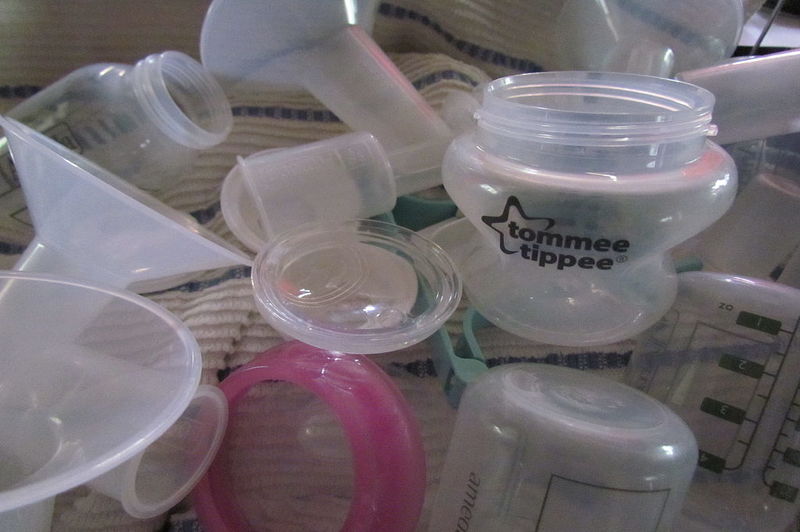The first step on how to remove mold from breast pump tubing is to detach the components of the equipment. From there, you will have to clean the parts individually.

Breast Pump Tubing And Mold Growth
Breast pumps have two types. One is closed or sealed; the other one is open or non-sealed.
The only difference is that the sealed breast pump has a backflow protector, which serves as a barrier. If you use a closed system breast pump, then you’re less likely to encounter mold.
However, if you use open system ones, you may encounter moisture or condensation of milk. Condensation of these substances will then lead to mold growth.
Mold growth in your breast pump is hazardous to your child because the breast milk will be contaminated. As we know, mold has several adverse health effects, and children are especially vulnerable to it.
The leading cause of mold growth in your breast pump tubing is moisture. Hence, it would be best to remove the moisture from the tubing before it leads to the dreaded fungi growth.
A tip on removing condensation from a breast pump tubing
Since condensation is the leading cause of mold growth in a breast pump tubing, you have to know how to remove it for mold prevention. Here is a tip on how to remove condensation from your tubing.
Instead of putting it in a sterilizer and risk it getting wet, remove the tubing from the breast pump. Then, fetch a can of compressed air that is usually used for keyboards.
After that, stick it in the tubing and let the air from the can pass through the tube. That’s it; you’ve removed the condensation from your breast pump tubing.
Removing Mold From Breast Pump Tubing
Step #1. First, turn off the breast pump and unplug it. Then, remove the parts and clean them individually.
Separate the tubing from the container, flange, and breast shield. Detach the breast pump tubing from the equipment.
Make sure you do not twist and destroy the tube as you detach it.
Step #2. After that, use clean and drinkable water to rinse your breast pump tubing. We recommend using a breastmilk removal soap to remove stubborn residues.
After using soap, rinse the tubing again.
Step #3. After washing the tubing, sterilize the tubing using rubbing alcohol. This would remove the residue.
Evaluate the strength of your tubing and if it is thick enough, leave it in hot water to kill off the mold. If you need proof of mold dying at a specific temperature, here’s an article talking about the temperature at which mold dies.
Step #4. After killing off mold, you must dry the tubing before installing it back on your equipment. Even a small amount of moisture may invite mold spores to settle on your tubing.
There are several ways to dry your tubing. You can hang it out to dry.
An alternative is to install the tubing on the pump without attaching the other end of the tubing to the breast shield.
After that, turn on the breast pump. Air will pass through the tubing, which will dry the component.
You can also use the tip we shared above that involves using compressed air.
Tips on preventing mold from breast pump tubing
1. Choose a breast pump with a barrier
Choose equipment that better protects your child from getting in contact with mold. To know more about mold ingestion, here is an article outlining what happens when someone drinks mold.
2. Clean after use
After using breast pumps, you should naturally clean all the parts that come in contact with breastmilk. The components should be dried thoroughly as well.
The parts that should be cleaned are valves, bottles, breast shields, tubing, and flanges. Wash them with dishwashing soap and rinse them with hot water.
You can dry them on a rack with a paper towel, but you can opt to use a dishwasher as long as it has a drying cycle. Do not use cloth towels as they may contain bacteria.
Mold in breast milk: what to do next?
First, inform your baby’s provider, especially if they drank the milk. A premature baby is especially vulnerable to mold, so this is a difficult situation.
Make a habit of checking your stored breast milk before feeding your baby. If the milk has foreign material of any kind, discard it.
Then, get to the bottom of how your breast milk acquired mold. If you washed your pump three days ago, note that all of the milk pumped in the last three days has been contaminated.
After that, think about what you can give your offspring in the meantime. Consider looking for a hypoallergenic formula or donor milk.
You can ask your doctor about these concerns as well. They may even lead you to some lactation consultants or medical specialty providers.
Conclusion
Knowing how to remove mold from breast pump tubing would save you from hospital trips because of accidental mold ingestion. Anything that involves mold should be treated with haste so that it won’t lead to drastic consequences.
We hope this article about breast pump mold was enlightening.
